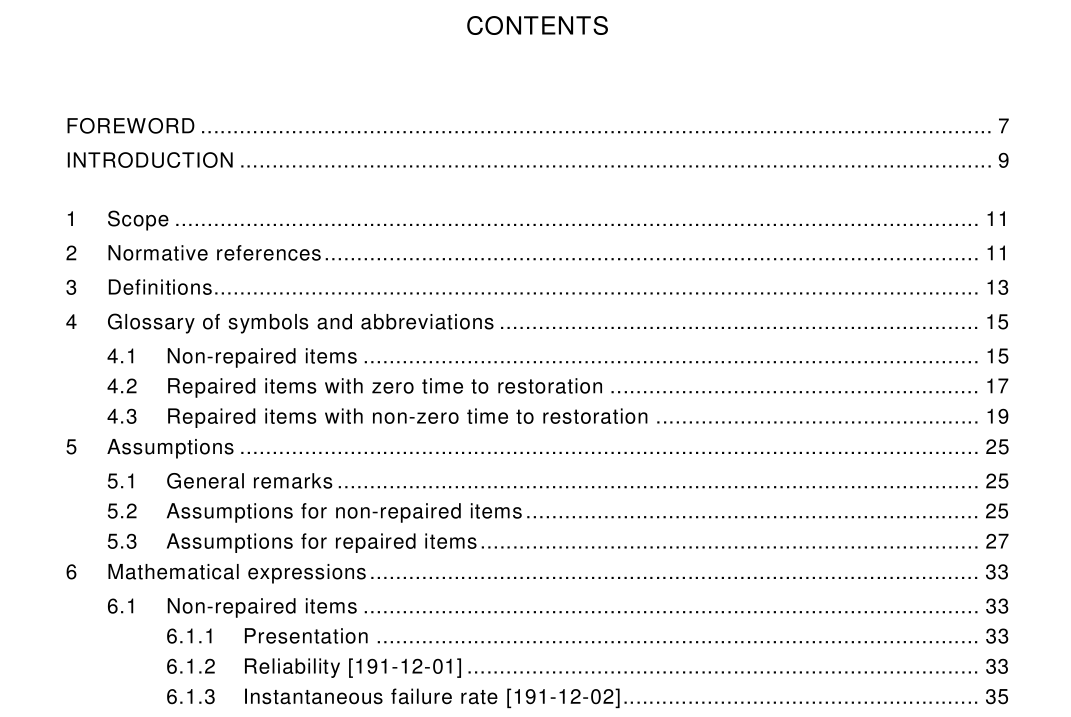IEC 61703 pdf download

IEC 61703 pdf download.Mathematical expressions for reliability, availability, maintainability and maintenance support terms
1 Scope
This International Standard provides mathematical expressions for reliability, availability, maintainability and maintenance support measures defined in IEC 60050-191. The following classes of items are considered separately in this standard: – non-repaired items; – repaired items with zero time to restoration; – repaired items with non-zero time to restoration. In order to keep the mathematical formulae as simple as possible, the following basic mathematical models are used to quantify dependability measures: – random variable (time to failure) for non-repaired items; – simple (ordinary) renewal process for repaired items with zero time to restoration; – simple (ordinary) alternating renewal process for repaired items with non-zero time to restoration. To facilitate location of the full definition, the IEC 60050-191 reference for each term is shown (in parenthesis) immediately following each term, for example: mean time to restoration [191-13-08] The application of each dependability measure is illustrated by means of a simple example. NOTE This standard is mainly applicable to hardware dependability, but many terms and their definitions may be applied to items containing software. Some of the software dependability aspects are explained in annex D.
2 Normative references
The following normative documents contain provisions which, through reference in this text, constitute provisions of this International Standard. For dated references, subsequent amendments to, or revisions of, any of these publications do not apply. However, parties to agreements based on this International Standard are encouraged to investigate the possibility of applying the most recent editions of the normative documents indicated below. For undated references, the latest edition of the normative document referred to applies. Members of IEC and ISO maintain registers of currently valid International Standards. IEC 60050-191:1990, International Electrotechnical Vocabulary (IEV) – Chapter 191: Dependability and quality of service ISO 3534-1:1993, Statistics – Vocabulary and symbols – Part 1: Probability and general statistical terms
5 Assumptions
5.1 General remarks In order to derive correct mathematical expressions for the measures defined in IEC 60050-191, the distinction needs to be made between repaired items [191-01-02] and non-repaired items[ 191-01-03]. The following classes of items are considered separately in this standard: non-repaired items; repaired items with zero time to restoration; repaired items with non-zero time to restoration. In order to keep the mathematical formulae as simple as possible, the following basic mathematical models are used to quantify dependability measures: 一random variable (time to failure) for non-repaired items; simple (ordinary) renewal process for repaired items with zero time to restoration; simple (ordinary) alternating renewal process for repaired items with non-zero time to restoration. For repaired items, the basic model is a simple renewal process, when the time to restoration of the item may be neglected, or a simple alternating renewal process when the time to restoration of the item is non-zero. In the latter case, the item alternates between an up state and a down state, and a widely used measure of reliability of the item is the failure intensity, which is equal to the renewal density. 5.3 Assumptions for repaired items a) At any instant of time, the repaired item may be either in an up state or in a down state (see figures 2 and 3). b) At time t = 0, the item is in an up state and is as good as new. Latent faults are not considered. c) Unless otherwise stated, when the item is in the up state, it is considered to be continu- ously operating. d) Consecutive up times of the item are statistically independent, identically distributed, positive and continuous random variables with finite expectations. . e) Consecutive down times of the item are statistically independent,identically distributed and non-negative random variables with finite expectations. In the case of non-zero down- time duration, the random variables are continuous with a common probability density function. f) The up times are statistically independent of the down times. g) Preventive maintenance or other planned actions that render the item incapable of performing a required function are not considered. In other words , any transition from an up state to a down state is a failure; any transition from a down state to an up state is a restoration; any down state is a fault and, in consequence, the down time is equal to the time to restoration; after each restoration the item is as good as new.









